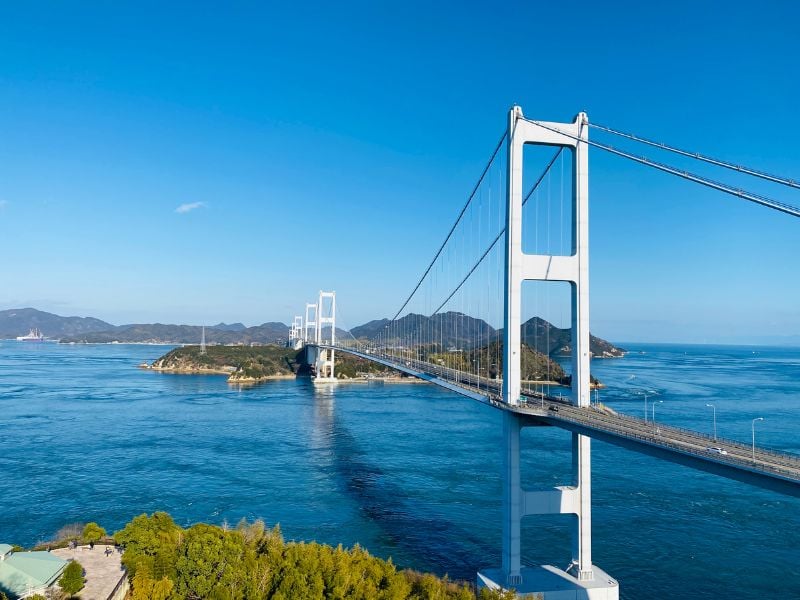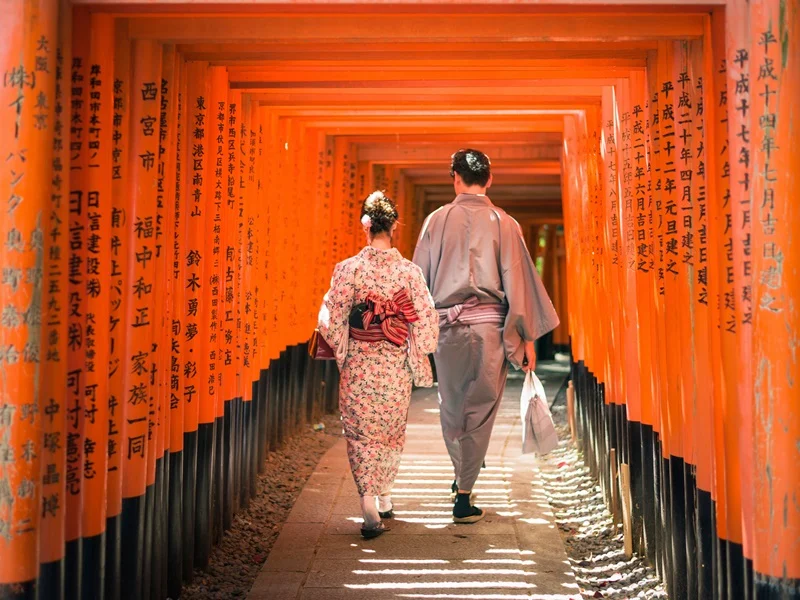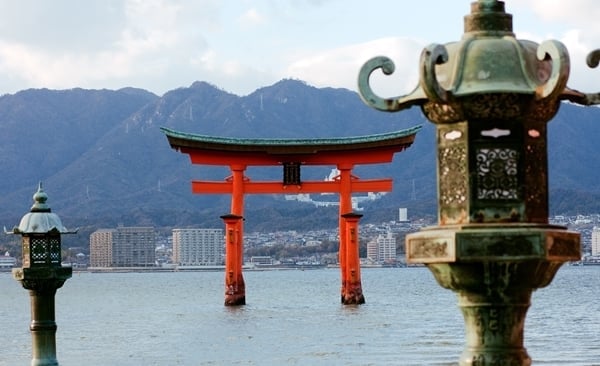Set off on a grand adventure themed around the calm waters of them Seto Inland Sea. Using a variety of modes of transportation, discover the historic ports and inspiring art islands that dot the coastline. With a unique itinerary through villages and cities, see a fascinating side of Japan that is often overlooked.
Itinerary
📍 Distance and journey time (approximation): Kansai International Airport (KIX) to Central Osaka: 1 h
Upon arrival to Osaka’s airport, our representative will be waiting to assist with sorting the appropriate transportation into the city (boarding the right train or selecting the correct shuttle bus).
The remainder of the day is free at leisure to explore Osaka independently.
Optional Evening Tour: Flavor of Osaka
Today’s tour begins at 17:00 or 18:00 depending on whether it is shared or private. Osaka is an epicurean’s delight. Indeed, the motto that the city’s exuberant inhabitants live by is kuidaore – “to eat oneself bankrupt.”
The first stop will be to try a new style of tempura in an eatery tucked away in a small alleyway. Old favourites such as shrimp tempura, and more experimental combinations such as asparagus tempura and cheese can be found on the menu.
Next, head to a restaurant specialising in wagyu beef dishes. Often referred to as the most expensive beef in the world, wagyu beef is of a superb quality, and is on many a gourmet’s wish list. Enjoy the melt-in-the-mouth textures with a refreshing cocktail.
After walking around the atmospheric backstreets, the final stop will be a small teppanyaki restaurant to try some delicious gyoza and negiyaki cooked on a metal plate right in front of guests.
Bid farewell to the affable guide, and either return to the hotel or go for a stroll around the neighbourhood to take in the sights.
Time:
Start: 17:00 (shared), 18:00 (private)
Duration: approx. 3 h
Overnight in Osaka
Inclusions:
📍 Distance and journey time (approximation): Shin Osaka Station to Okayama Station: 50 min
Today is a self-guided day.
This morning take the train to Okayama.
Suggested Self-Guided Itinerary:
Visit Okayama Castle, also known as the “Crow Castle” for its black exterior. Although completed in the late 1500s, the structure that we see today only dates back to 1966 because of countless renovations caused by fires.
Next head to Korakuen Garden, hailed as one of the Three Great Gardens of Japan and a designated Special Place of Scenic Beauty. The only way to get to the garden from Okayama Castle is via Tsukimi Bashi Bridge, a steel and concrete bridge that crosses over Asahi River.
Continue in mid-afternoon to the nostalgic Kurashiki Bikan and Canal Area filled with traditional houses and shops with sliding doors and lattice windows.
If time permits, pay a visit to the Ohara Museum of Art, the first and oldest Western art museum in Japan. On display are the works of some of the most well-known artists in the world such as El Greco, Matisse, and Picasso.
Overnight in Okayama
Inclusions:
☕ Breakfast
📍 Distance and journey time (approximation): Okayama Station to Takamatsu Station: 1 h
At a convenient time, begin the journey to Shikoku, one of the four main islands in Japan located between the Seto Inland Sea and the Pacific Ocean. Shikoku is a popular destination for pilgrimage tours and ecotourism, for its numerous temples and shrines, as well as valleys, gorges, and mountains.
Reach Takamatsu by train, the closest point in Shikoku to main Honshu Island. It flourished as a castle town during the feudal era and now serves as a gateway for tourists wanting to visit the neighbouring art islands such as Naoshima and Teshima.
Suggested Self-Guide Itinerary:
Leave luggage at the hotel and head to Ritsurin Park, one of the designated Special Places of Scenic Beauty in Japan. It is a 75-hectare property set against Mt. Shiun that features thirteen man-made hills, six ponds, oriental bridges, and a wide variety of trees and flowers such as the Crane and Turtle Pine Tree, the Evergreen Oak Tree, irises, and azaleas.
The park was originally built in the 1620s to serve as a private garden for the then leaders of Kagawa prefecture, the Ikoma Family, and after more than a century, the garden was completed and became the villa of the succeeding Matsudaira family. After the restoration of the Meiji era, it was opened to the public and has become one of the favorites of both locals and foreign tourists since then.
Take a break and have an afternoon tea at Kikugetsu-tei, a teahouse set right in the middle of the park. Spend a pleasant time with a cup of green tea and a view of Nan-ko pond.
Overnight in Takamatsu
Inclusions:
☕ Breakfast
📍 Time: Start (guided tour): 08:00 Duration: 10 h
Today’s daytrip begins at 8:00 at the Takamatsu port, where a local guide – who is a fellow art lover, of course! – will be waiting to board a ferry departing at 8:12.
Upon arrival at Naoshima Island, pick up electric bikes to reach the art sites scattered about the Mediterranean-like island.
Begin with an overview of Naoshima’s port area and learn how the district has been transformed by a number of interesting architectural projects. Get a deeper look inside the island’s art installations by visiting several of the House Projects, renovated homes with meaningful art interiors that act as tangible memories of the island’s past and present. The guide will suggest a route of approximately five of these sites, and work with guests to choose the most interesting locations based on their tastes.
After lunch at a local cafe, spend the afternoon visiting the sprawling Benesse Museum. This is one of Japan’s most important centers of contemporary art, and a lovely campus that is sure to delight visitors. Benesse Park rolls along the coast, where guests will find the famous seaside Yellow Pumpkin of Yayoi Kusama. (The Benesse area is only accessible by foot, bikes will be parked nearby)
Pick up the bikes again and cycle back to the port, where a departing ferry awaits.
Return to Takamatsu and part ways with the guide.
Overnight in Takamatsu
Inclusions:
☕ Breakfast
📍 Distance and journey time (approximation): Takamatsu Station to Imabari Station: 1h 50 min Time: Start (guided tour TBA) Duration: 8.5 h Journey: approx. 45 km
After breakfast, take the train to the town of Imabari and meet the guide for a tour briefing and get comfortable with the E-bikes. A van will also be waiting to take any luggage and transfer it to the accommodation, and to refill any water bottles before setting off for the cycling tour on the Shimanami Kaido, an 80-kilometre long route traversing the bridges and islands of the Seto Inland
Sea. This route is the only road for cyclists and pedestrians that connects the main island Honshu to the island of Shikoku.
The route today is a 40-kilometre course, passing through three iconic bridges, including the Kurushima Kaikyo, the longest bridge. Enjoy the scenic pedal along to Oshima Island, take a lunch break and hop back on the bikes and cycle 18km to the next island. Stop off at Oyamazumi Shrine and learn of its ancient history where many samurai came to pray for victory in battle and left their armour after their success.
The shrine now is home to an impressive collection of samurai armour and weaponry which are considered as National Treasures. One particular suit of armour belongs to Tsuruhime, a 16 year old girl from Omishima Island known now as a samurai princess, or Joan of Arc figure, and one of very few female warriors in Japanese samurai history.
Cycle the last 5 km to reach your accommodation for the night. In the evening enjoy a delicious BBQ dinner and take a well-deserved rest.
Overnight in Omishima
Inclusions:
☕ Breakfast, 🍗 Dinner
📍 Duration and journey time (approximation): Mihara Station to Hiroshima Station: 30 min
This morning take the shuttle transfer from the lobby to the port and board a ferry from Omishima Island to Tadanoumi. Meet the local guide and head to the picturesque city Takehara.
Take a stroll down the historic district of Takehara, stepping back 350 years in time along the perfectly preserved Edo era streets. Pass by old houses and public buildings belonging to the leading sake and salt merchants that brought an abundance of wealth to the area.
One of many interesting stops along the district is a statue of the founder of the Nikka whisky distillery, Taketsuru Masataka, known as the father of Japanese whisky and born and raised in Takehara.
After lunch head to a traditional townhouse for a bamboo brush making and calligraphy experience. Bamboo or take in Japanese, is what makes up the name Takehara and is another important resource of the city. With the district’s bamboo themed festivals and bamboo workshops, one cannot leave Takehara without taking some back home.
The final stop of the tour will be Fujii Shuzo sake brewery, the oldest sake brewery in Takehara with many awards under its belt. Meet master brewer Mr. Fuji himself for some sake tasting and captivating conversation about their handcrafted brewing process over a 150 year history. In a traditional washitsu room with a garden view, relax and admire each delightful smell and taste of the different sake.
Visit the Fujii Shuzo sake shop and try a little more of the sake before saying goodbye to Mr. Fuji and the guide. Take a taxi to Mihara station and board the train to Hiroshima.
Note:
-Luggage will need to be taken by hand from the accommodation to Tadanoumi Port and then will remain in the guide’s vehicle until the taxi transfer to Mihara.
Overnight in Hiroshima
Inclusions:
☕ Breakfast
📍 Time: Start (guided tour): 09:00 Duration: 8 h *including pick-up/drop-off and transit times
Together with the guide, explore the island and sample some local delicacies like oysters, saltwater eel, and maple leaf-shaped cakes.
Start with Itsukushima Shrine, declared as one of Japan’s three most beautiful views. The shrine is designed in a pier-like structure and dates back to the 6th century. Its huge vermillion o-torii gate seems to be floating in the water during high tide.
Walk towards the mountain to visit Daisho-in, the most visited Buddhist temple on the island. Along the stairs is a row of spinning sutras that lead up to the main hall. It is believed that anyone who spins these sutras will be blessed.
Early in the afternoon head to Hiroshima to visit Peace Memorial Park and Museum. There is also the heart-rending A-Bomb Dome and the Children’s Peace Monument.
Overnight in Hiroshima
Inclusions:
☕ Breakfast
📍 Distance and journey time (approximation): Hiroshima Station to Kyoto Station: 1h 40 min Time: Start (cultural activity): 15:30 Duration: 2 h
Get on the bullet train to Kyoto, the reigning cultural capital of Japan, home to 2,000 shrines and temples with 17 UNESCO World Heritage Sites.
Today, be immersed in Japanese culture with this insightful half day trip in Kyoto. Start with a visit to a machiya, a traditional wooden townhouse found throughout Kyoto. Take a tour of the beautifully restored house, learning about its architecture and history.
Then slip into a kimono, the iconic traditional Japanese garment. These full-length robes are worn by all Japanese when attending important events or formal occasions. Once appropriately dressed, meet with a local tea master for a traditional ceremony. Watch and learn as the master brews and services tea using slow, deliberate movements steeped in spirituality and ritual. Enjoy a cup of the bitter tea along with traditional sweet treats.
After the tea is finished, continue the cultural exploration of Kyoto. Experience an introductory course in origami, the Japanese art of paper folding. Under the guidance of a local artist, learn the secrets behind creating beautiful decorations and images with simple pieces of paper.
Wrap up the half day trip in Kyoto with new insights and a better understanding of Japanese culture. Return to the hotel or continue to explore Kyoto’s charming streets.
Overnight in Kyoto
Inclusions:
☕ Breakfast
📍 Time: Start (guided tour): 09:00 Duration: 8 h *including pick-up/drop-off and transit times
Today’s tour starts with a visit to one of Kyoto’s most iconic sites: the Fushimi Inari Shinto Shrine. A lavishly decorated building houses the goddess of rice, and thousands of orange torii gates stretch up the mountainside in long tunnels. Unlike any other shrine in Japan, this is an ideal spot to understand how Shintoism is tied to respect for nature.
Board a train to Sanjusangendo, a stunning Buddhist temple often overlooked by tourists. A mesmerizing display of 1001 life-sized golden Buddhist statues awaits inside the world’s longest wooden building, sure to be one of the most memorable sights of the entire trip.
Take a taxi to the entrance of Nishiki Market, a long covered street of shops and stalls often called “Kyoto’s kitchen.” From traditional to sellers of tofu, fish, and pickles to shops showcasing knives and handicrafts, there is a tantalizing amount of things to see and taste here.
Don’t get too full snacking in the market, as lunch is next at a nearby restaurant. The guide will suggest locations based on the guests’ preferences (guests should notify guide of dietary restrictions at the start of the tour).
After lunch, travel to Nijo Castle, an ornamental palace built for the shogun in the early 1600s. The beautiful building is known for its finely painted walls and “chirping nightingale” floors that squeak under the feet of intruders. Walk the halls, see the audience chambers, and experience what it was like to visit the military ruler of Japan in the classic era of samurai.
Hop aboard the subway for a short ride to the eastern foothills of Kyoto. The final location of today is Nanzenji Zen Temple, a quiet retreat where monks have lived in peaceful repose since 1291. See the famous Zen rock garden whose meaning is left up to the viewer. Is it meant to be islands in a calm ocean, or a depiction of wild animals crossing a raging river?
After a full day of sightseeing, part ways with the guide and return to the hotel or continue to explore independently.
Part ways with the guide and continue exploring the city independently.
Overnight in Kyoto
Inclusions:
🥘 Lunch
📍 Distance and journey time (approximation): Kyoto to Kansai International Airport (KIX): 2 h
The rest of the day is at leisure until the scheduled transfer via train to Kansai International Airport.
Inclusions:
You might also like...
Here is a selection of products that may also fit the needs of your client.
Become a partner-
You might also like...
Here is a selection of products that may also fit the needs of your client.
Become a partner -
-
-
Get in touch
Our sales team is on hand to ensure that the process of working with us is as smooth as possible. If you should have any questions, feel free to reach out to them.
















